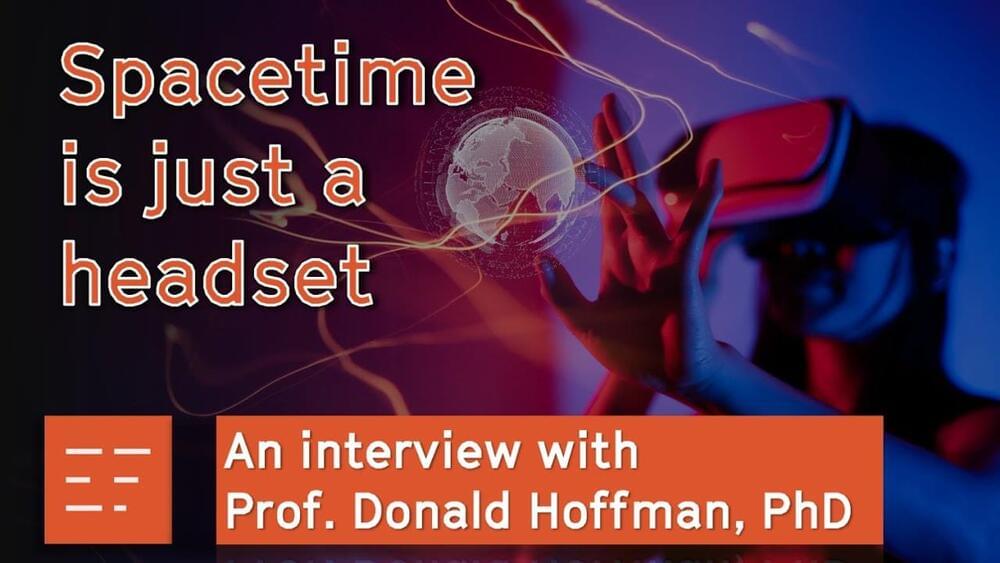Oct 11, 2023
Digital insomnia caused by screen time before bedtime
Posted by Shubham Ghosh Roy in category: neuroscience
If you spend time online before you go to bed, you could be hurting your chances for a good night’s sleep.
If you spend time online before you go to bed, you could be hurting your chances for a good night’s sleep.

Prof. Donald Hoffman talks to Essentia Foundation’s Hans Busstra about his theory of conscious agents, according to which space and time are cognitive constructs in consciousness, not an objective scaffolding of the world outside. The interview also touches on Prof. Hoffman’s personal history and life, bringing the warmth of his humanity to the academic rigor of his theories.
00:00 Intro: Beyond the spacetime headset.
03:32 About Donalds personal background.
07:35 On the importance of mathematics.
13:22 Quantum theory and spacetime.
19:24 Why exactly is spacetime ‘doomed’?
24:34 Did physics ‘encounter’ consciousness in quantum theory?
32:49 On heavy vs light metaphysical claims.
37:36 How is your theory affecting your personal life?
42:17 Is The Matrix a good metaphor?
46:38 How can the space time interface affect consciousness?
53:09 What makes you say that if spacetime is not fundamental, consciousness must be fundamental?
55:44 Physicalism fails to give an accurate model of consciousness… 1:00:24 How can we put the spacetime headset off? 05:39 Beyond the spacetime fantasies of Christopher Nolan and the Matrix… 1:09:27 The ontology of conscious agents 1:15:05 Are meditation and psychedelics ‘hacks’ in the interface? 1:21:41 Should we revalue religious and mystic literature? 1:29:54 Could idealism as a worldview help us better solve the challenges humanity faces? 1:34:23 The role of mathematics in bringing together science and spirituality Copyright © 2022 by Essentia Foundation. All rights reserved. https://www.essentiafoundation.org.
1:00:24 How can we put the spacetime headset off?
05:39 Beyond the spacetime fantasies of Christopher Nolan and the Matrix…
1:09:27 The ontology of conscious agents.
1:15:05 Are meditation and psychedelics ‘hacks’ in the interface?
1:21:41 Should we revalue religious and mystic literature?
1:29:54 Could idealism as a worldview help us better solve the challenges humanity faces?
1:34:23 The role of mathematics in bringing together science and spirituality.
Continue reading “Spacetime is just a headset: An interview with Donald Hoffman” »
Of course, this study was performed on a relatively small group of individuals in an agricultural community, which is not the environment that most American teenagers grow up in. These links may also be due to some other confounding factors, like spending more time on the farm than in formal education. However, these results are still striking and important to consider for young people in farming communities (and non-farming communities) around the world.
“Many chronic diseases and mental-health disorders in adolescents and young adults have increased over the last two decades worldwide, and exposure to neurotoxic contaminants in the environment could explain a part of this increase,” senior author Jose Ricardo Suarez, an associate professor in the Herbert Wertheim School of Public Health, said in a statement.
“Hundreds of new chemicals are released into the market each year, and more than 80,000 chemicals are registered for use today,” Suarez added. “Sadly, very little is known about the safety and long-term effects on humans for most of these chemicals. Additional research is needed to truly understand the impact.”

https://soundcloud.com/bergscloud/
Music promoted by https://www.chosic.com/free-music/all/
Creative Commons CC BY-SA 3.0
https://creativecommons.org/licenses/by-sa/3.0/
The world’s largest study on light exposure and its impact on mental health, with almost 87,000 participants, has found that increased exposure to light at night increases a person’s risk for psychiatric disorders such as anxiety, bipolar and PTSD severity as well as self-harm. Importantly, the study also found that increasing exposure to daytime light can act like a non-pharmacological means for reducing psychosis risk.
In those exposed to high amounts of light at night, the risk of depression increased by 30%—while those who were exposed to high amounts of light during the day reduced their risk of depression by 20%. Similar patterns of results were seen for self-harm behavior, psychosis, bipolar disorder, Generalized Anxiety Disorder, and PTSD. These findings indicate that the simple practice of avoiding light at night and seeking brighter light during the day could be an effective, non-pharmacological means of reducing serious mental health issues.
The study, led by Associate Professor Sean Cain, from the Monash School of Psychological Sciences and the Turner Institute for Brain and Mental Health in Melbourne, Australia, is published today in the journal, Nature Mental Health.
The number of kids being diagnosed with autism spectrum disorder (ASD) and attention deficit hyperactivity disorder (ADHD) has risen sharply in recent decades, and a new study points to the common plastic additive bisphenol A (BPA) as a potential reason why.
BPA is used in a lot of plastics and plastic production processes, and can also be found inside food and drink cans. However, previous research has also linked it to health issues involving hormone disruption, including breast cancer and infertility.
In this new study, researchers from Rowan University and Rutgers University in the US looked at three groups of children: 66 with autism, 46 with ADHD, and 37 neurotypical kids. In particular, they analyzed the process of glucuronidation, a chemical process the body uses to clear out toxins within the blood through urine.
Researchers say they have linked shorter telomeres on white blood cells to higher dementia risk, although outside experts say there are limitations to this study.
A breakthrough technique developed by University of Oxford researchers could one day provide tailored repairs for those who suffer brain injuries. The researchers have demonstrated for the first time that neural cells can be 3D-printed to mimic the architecture of the cerebral cortex. The results have been published in the journal Nature Communications.
Brain injuries, including those caused by trauma, stroke, and surgery for brain tumors, typically result in significant damage to the cerebral cortex (the outer layer of the human brain), leading to difficulties in cognition, movement and communication. For example, each year, around 70 million people globally suffer from traumatic brain injury (TBI), with 5 million of these cases being severe or fatal. Currently, there are no effective treatments for severe brain injuries, leading to serious impacts on quality of life.
Tissue regenerative therapies, especially those in which patients are given implants derived from their own stem cells, could be a promising route to treat brain injuries in the future. Up to now, however, there has been no method to ensure that implanted stem cells mimic the architecture of the brain.
W/ Dr. Joseph T. Lizier of U Sydney. Amalytic relationship of relative synchronizability to network structure & motifs.